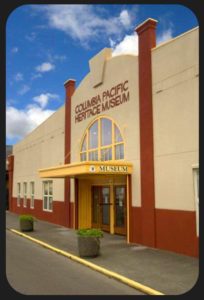Passenger and freight traffic on the “Clamshell Railroad” peaked around 1913, and began to decline throughout the 1920’s. Automobiles, buses and trucks, improved roads and the ferry lines to Astoria captured the railroad’s business. Unsuccessful attempts were made to sell the railroad, and finally the Union Pacific ceased operation of the line.
The last run of the “Clamshell Railroad” took place on September 9, 1930. Ilwaco students were dismissed early from school, the mayor made a farewell speech, and a bugler played “Taps” as the train left. Ken Inman fired a final salute from the old cannon. The whistle sounded as the train headed north to Nahcotta for the last time. On board was Mrs. William Begg who had the distinction of riding the first train to Ocean Park in 1889, and last train in 1930.
A contract to remove the rails was signed in March of 1931. By the end of May 1931 a work train had taken up the rails between Nahcotta and Ocean Park and was heading south. The rails were sold to China as scrap.
By the end of 1931, the Megler Terminal was abandoned while the car ferry terminal to Astoria remained there until 1966. Passenger coaches were sold off as cottages, depots found new lives, such as: a motel (now Long Beach community center), a gas station (Ocean Park), a tavern and restaurant (Seaview)
In 1987, the Ilwaco Freight Depot was moved from its original site to its now present location in the courtyard of the Columbia Pacific Heritage Museum. It is now housed with the passenger car NAHCOTTA,½ block east of the original railroad tracks in Ilwaco.
Remembering the Railroad
In the 1920s, students from other communities rode the train to and from the consolidated school in Ilwaco.
“I rode the train everyday to and from high school for four years. The cost was 10¢ each way. Some days, if I was late getting out the door, the train would wait for me! My Dad, Gilbert Tinker, built me a little wooden walkway from our house out to the train tracks so that my feet would stay dry since Long Beach was troubled with water drainage problems then. I can still see the train chugging along those tracks, especially on the section of road going past Black Lake and into Ilwaco.”
– Lolita Tinker Morris, May 30, 2003
Using the Railroad Right-of-Way:
“People on foot traveled up and down the railroad tracks. We kids walked to Sunday school in Long Beach – 3 miles down and 3 miles back. We also went at times to the movies in Long Beach walking home in the dark.”
– Verna Smith Oller, July 12, 2003
Children Having Fun:
“Holman Station was a small building with three enclosed sides and the front open that was located next to the water tower to the left of Holman Road, behind the Ohme residence. … As a child, she [Frances Ohme] and the neighbourhood children played around the station house and tank which stood for some time after the railroad ceased to run. Their favourite game in the station house was “Kitten in the Corner” and she said she couldn’t understand why someone didn’t break a few bones as they climbed and played on the water tank.”
– Frances Ohme Burton
Childhood Impressions:
“… When school was out, our family, comprised of six children, packed our flour sacks with summer clothing and proceeded to walk to the railroad station, a distance of three blocks from our house.
“… My earliest recollection at probably seven or eight years old was of the coach we entered which had beautiful cranberry red plush upholstery on the seats. There was also an interesting aspect, the seats could be turned backward and forward depending on which direction the train was traveling. What an amazing trip we would be taking that day.”
– Charlotte Herrold Davis (Chinook Observer, January 31, 2007)
